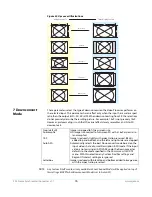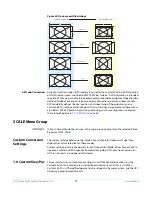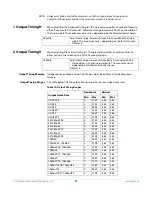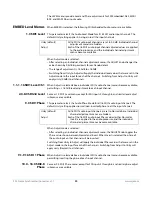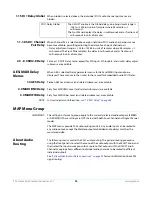
www.aja.com
88
FS4 Frame Synchronizer/Converter v1.1
Chapter 5: Browser Remote Control
Remote FS4 Control Via a Web Browser
The FS4 web interface consists of a built-in optimized web server that provides control
via a web browser running on a network-attached computer. The browser screens are
presented and described on the following pages, organized as they appear in the
browser.
Supported browsers
• Chrome (all platforms)
• Firefox (all platforms)
• Safari (OSX, Mobile)
• Internet Explorer (versions 10 and higher)
Other browsers are likely to work but are not guaranteed.
Supported RJ45 Ethernet
network connections
• Closed local area network (LAN)
• Straight computer to FS4 cable connection
• Broadband wide area network (WAN) with the firewall opened for the FS4 (not
recommended since anyone on the internet can then access the FS4)
Internally the FS4 senses and adapts to either a “straight-through” CAT 5 Ethernet cable
or null-modem (crossover) cable using standard RJ45 connectors. No setup or strapping
is needed to adapt to the cable.
Browser connection
For browser access, enter the FS4 IP address in the browser's address field.
By default, the FS4 is set to automatically connect to your network's DHCP server to get
an IP address and other network configuration data. You will find the IP address in the
STATUS
Menu Group as follows:
1. Press the
STATUS
button on the FS4 front panel.
2. Turn the
SELECT
knob until you reach status display with the FS4 name at the top.
3. Enter the IP address shown in the IP Addr field.
When the browser successfully connects to the FS4, the main
Status
screen is displayed. If
the browser fails to connect, make sure
CONFIG
settings for
IP, Subnet, and Gateway
match the network setup of the browser host. You can either make the computer match
the FS4, or make the FS4 match your computer.
General Web
Browser Screen
Description
The webpage screens are different, depending on the current FS4 operating mode. All
FS4 screens share some common elements:
Menu
On the left of each screen is a navigational list of the available screens. Click any of these
items to jump to that screen. Collapse/expand buttons on the upper right of each menu
lets you open and close that menu’s selection list.
Alarms
The lower left side of the screen shows alarms that alert you to possible problem
conditions, such as disconnected or failed power supplies and video format
incompatibilities.



